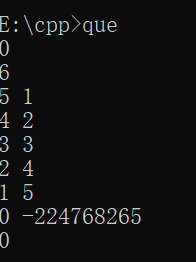Part 0:本文声明
本文只介绍基本写队列方法。
文章所有代码均为原创,转载请注明来源。
循环队列请看这里。
Part 1:啥是队列
一天,一群小可爱们在排队买奶茶。

店主认识第一个小可爱,给他打了骨折(大雾),小可爱买到了奶茶,他快乐的(真的?)离开了。

其他人往前挪一位:

然后,目前排在第一位的小可爱买了奶茶,一蹦一跳的离开了:

接下来,其他人往前挪一位:

这样进行下去,最后,只剩下了一位小可爱,他买了奶茶,兴冲冲的离开了:

没有人啦!奶茶店卖完了奶茶,兴冲冲的关门了。
这就是队列,先进先出的数据结构。
Part 2:手写队列
如果你已经搞清楚了队列是酱紫的,我们来尝试手写一下队列。
我们简单看一下刚才排队的过程,我们可以发现,一个队列需要实现:
- 增加(有人来买奶茶)
- 弹出第一个(买完奶茶走掉)
- 求队列中元素个数(有多少个人)
- 判断队列是否为空(到底有冇得人)
- 获取队首元素(看看第一个小可爱到底是谁啊,咱给他打个骨折)
那么,我们尝试用数组和结构体来实现一下:
1
2
3
4
5
6
7
8
9
10
| struct Queue{
int que[1000];
int head = 0;
int tail = 0;
void push(int x){}
void pop(){}
bool empty(){}
int num(){}
int getHead(){}
}
|
然后,我们来尝试写一下第一个函数push(int x):
1
2
3
| void push(int x){
que[tail++]=x;
}
|
tail++是个神奇的语句,不仅可以增加一个元素,并且还可以tail指向下一个元素,增加队列的长度。
第二个:push(),我们直接让head++:
第三个:empty(),直接tail-head,因为tail一定大于等于head,想想为什么:
1
2
3
| bool empty(){
return tail-head;
}
|
第四个num()其实和empty()很类似:
1
2
3
| int num(){
return tail-head;
}
|
第五个也极其简单:
1
2
3
| int getHead(){
return que[head];
}
|
完整代码:
1
2
3
4
5
6
7
8
9
10
| struct Queue{
int que[1000];
int head = 0;
int tail = 0;
void push(int x){ que[tail++]=x; }
void pop(){ head++; }
bool empty(){ return tail-head; }
int num(){ return tail-head; }
int getHead(){ return que[head]; }
}
|
我们拿去试下:
1
2
3
4
5
6
7
8
9
10
11
12
13
14
15
16
17
18
19
20
21
22
23
24
25
26
27
28
29
| #include <iostream>
using namespace std;
struct Queue{
int que[1000];
int head = 0;
int tail = 0;
void push(int x){ que[tail++]=x; }
void pop(){ head++; }
bool empty(){ return tail-head; }
int num(){ return tail-head; }
int getHead(){ return que[head]; }
};
int main(){
struct Queue queue;
for(int i = 0;i < 6;i ++){
queue.push(i);
}
cout << queue.getHead() << endl;
cout << queue.num() << endl;
for(int i = 0;i < 6; i++){
queue.pop();
cout << queue.num() << ' ';
cout << queue.getHead() << endl;
}
cout << queue.empty() << endl;
}
|
程序输出:

Part 3:STL里边的queue
别人也帮我们写了一个queue,我们来看看怎么用。
1
2
3
4
5
6
7
8
| #include<queue>
queue<int> q;
q.push(144514);
q.size();
q.front();
q.back();
q.empty();
q.pop();
|
尝试使用STL的queue写出买奶茶程序吧~









